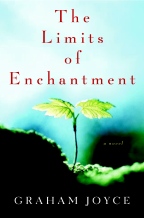The Limits of Enchantment
Victor Gollancz / Orion Books
UK Hardcover First Edition
ISBN 0-575-07231-8
Publication Date: 01-20-2005
256 Pages; £12.99
|

|
The Limits of Enchantment
Atria Books / Simon and Schuster
US Hardcover First Edition
ISBN 0-743-46344-7
Publication Date: 02-22-2005
272 Pages; $22.00
Date Reviewed: 11-05-04
Reviewed by: Rick Kleffel © 2004
|

|
|
REFERENCES
|
COLUMNS
|
|
General
Fiction, Horror, Fantasy
|
06-03-02, 08-22-02, 12-13-02, 01-07-03
|
"Trust the tale and not the teller," Fern Cullen tells us on the
first page of Graham Joyce's new novel, 'The Limits of Enchantment'.
"...listen hard. Not to your thoughts, which will mislead you, nor to
your heart, which will lie..." Graham Joyce knows a few things about
your heart, it seems. And he's unwilling to lie. Fern Cullen,
shedding the last of her sheltered teenage years amidst the English
midlands in 1966, tells the tale in Joyce's latest novel. Her voice
is rings true, rings close, rings clear, in gorgeous bell-tones that
carry the reader effortlessly, buoy us on a breeze, in a whisper.
She's learned a lot from her adopted mother, from her Mammy. The
passing of wisdom is commonplace in her life. The passing of wisdom
is quite uncommon in ours, and few are those who can do so with the
eloquence, the grace and the power of Graham Joyce. There are no
limits of enchantment within the experience of reading this novel.
The limits of Fern Cullen's life are quite clearly described in
her own voice, a voice that's consistently a joy to read. This is the
kind of book that readers will want to read aloud, from the dramatic
opening monologue to the closing coda. Joyce's prose is a delight to
encounter, page after page. Every paragraph yields a new treasure, a
new turn of phrase to be relished. Mammy is the last of the
traditional hedgerow midwives in her neck of the woods. She's the
woman to whom the other women in the village turn when they find
themselves in the family way and need help. She knows the herbs, the
rubs, the mixes and recipes that will set things right. But before
she sets things right, before she supplies the solution, she makes a
simple demand. She's to know the cause of the problem. She's to know
the name of the father.
Set in the years before abortion was made safe and legal, 'The
Facts of Life' offers a compelling look at the balance of power
between men and women, between tradition and science. Joyce's
portrait of hedgerow medicine is fascinating and detailed, as is his
portrait of rural England in 1966, as change sweeps across the land
and indeed around the world. In this microcosm of Fern's world, we
see the world at large. When a group of hippies inherit land near
Mammy's house, it signals the beginning of the end of Mammy's
traditions, and their rebirth in Fern.
What makes the novel so compulsively readable, so utterly
pleasurable goes beyond Joyce's easy-seeming prose. He presents for
his readers life in full, in its complete state, literally from
beginning to end and beyond. The variety of life, from tragedy to
farce is brought to life by his ability to weave humor and hint at
horror within a single scene, often within a single paragraph.
Readers will find themselves guffawing in one moment then holding
back a tear in the next. Joyce renders each scene in Fern's voice
with a breathtaking transparency. The tone of the novel shifts
naturally, entertainingly, as Fern and Mammy realize the limits of
their lives.
Joyce provides a compelling and intricate plot to structure the
novel. Within the flawlessly researched environment, Joyce has
managed to strip out any single word that might get in the way of
creating the story for the reader. The progression of the midlands
from an almost prehistoric level of civilization, notch by notch,
into the twentieth century, provides an intense drama. Because Joyce
so successfully manages to invest his readers in his characters, we
care dreadfully for what will happen to them.
The fascinating prehistoric elements of the novel provide the
underpinnings for ecstatic flights of visionary writing. Few writers
have a mastery of the surreal as engaging as Joyce. He knows
precisely how far to take the reader into those moments when the
supernatural, when the numinous, intrudes into our world and shifts
our perceptions beyond the details of our petty lives. He also has
the ability to make these visions applicable not only to the
characters in the novel but to the readers as well. By scratching
about in the universal unconsciousness, he manages to get universal
access. We all have a moment now and again when we feel the tug from
beneath and beyond. Joyce will bring you back to your moments as you
read of Fern's.
And reading is the point. Joyce writes a novel that offers an
almost handcrafted feel. Readers who encounter 'The Limits of
Enchantment' will find that every detail is attended to; every word
has earned its place in the novel. It's why he's able to pack so much
life into such a short space. Joyce writes the kind of novel that
readers can and should take very slowly, though the temptation will
be to read it in a single sitting. Don't, or if you do, realize that
you're likely to return to the first page and start again, to enjoy
every detail, to experience every laugh, every moment of mystery once
again. Joyce is one of our great novelists, one of the treasures of
our time. You need not accept my word for it. Pick up the book.
"Trust the tale and not the teller."

